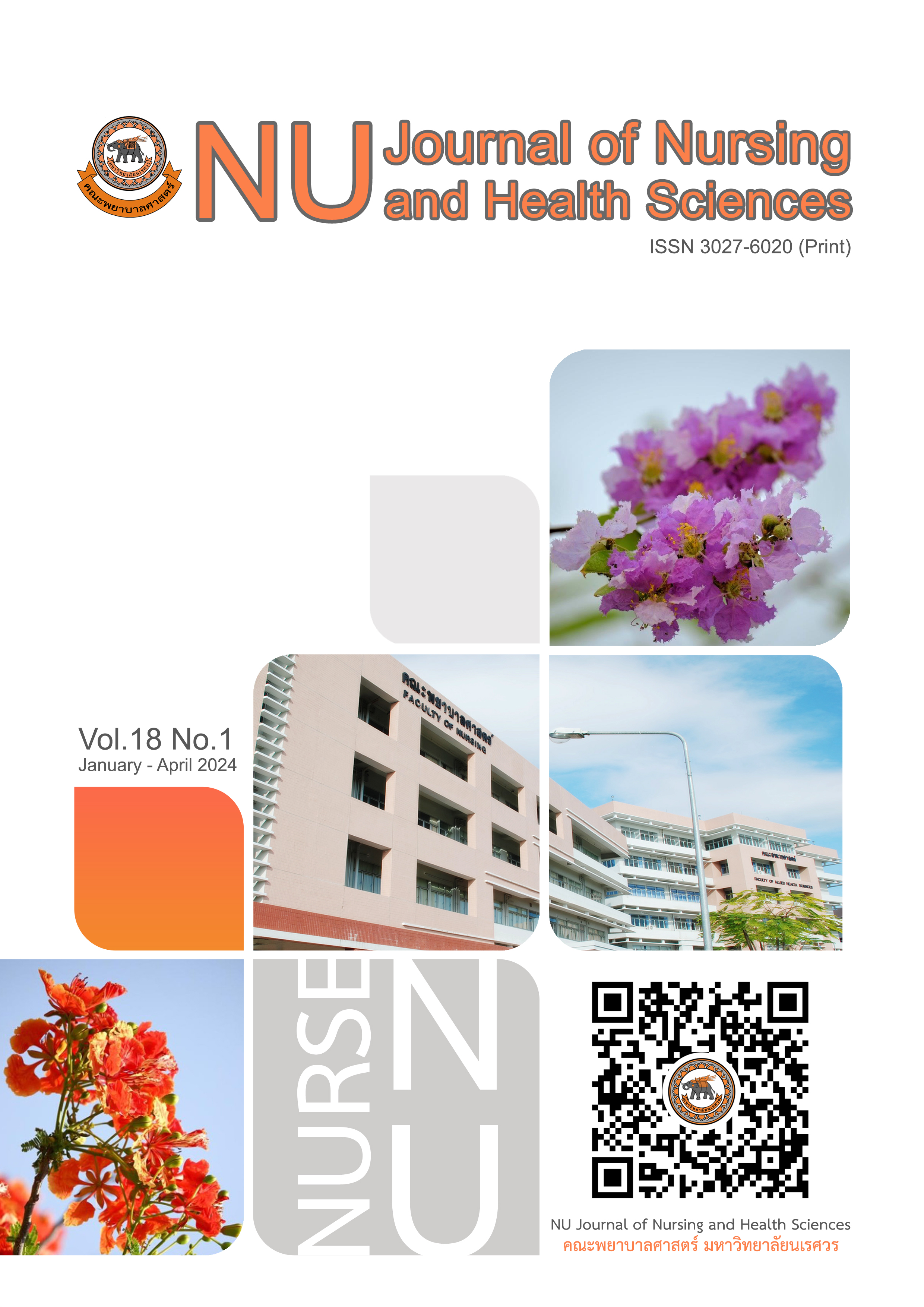ผลของโปรแกรมการบริหารแบบมีส่วนร่วมต่อผลลัพธ์การใช้แนวปฏิบัติการพยาบาล ผู้ป่วยติดเชื้อในกระแสเลือดของพยาบาลวิชาชีพโรงพยาบาลตติยภูมิแห่งหนึ่ง
Main Article Content
บทคัดย่อ
งานวิจัยแบบกึ่งทดลอง มีวัตถุประสงค์เพื่อศึกษาผลของโปรแกรมการบริหารแบบมีส่วนร่วมต่อผลลัพธ์การใช้แนวปฏิบัติการพยาบาลผู้ป่วยติดเชื้อในกระแสเลือดของพยาบาลวิชาชีพ กลุ่มตัวอย่าง คือ พยาบาลวิชาชีพที่ปฏิบัติงานในหอผู้ป่วยอายุรกรรม จำนวน 60 คน แบ่งเป็นกลุ่มทดลอง 30 คน และกลุ่มควบคุม 30 คน โดยใช้วิธีสุ่มตัวอย่างแบบเจาะจงเครื่องมือที่ใช้ในการวิจัย ประกอบด้วย โปรแกรมการบริหารแบบมีส่วนร่วม และแบบสอบถามการใช้แนวปฏิบัติการพยาบาลผู้ป่วยติดเชื้อในกระแสเลือด ตรวจสอบคุณภาพของแบบสอบถามได้ค่าความตรงเชิงเนื้อหาเท่ากับ 0.97 หาความเชื่อมั่นโดยค่าสัมประสิทธิ์แอลฟาของครอนบาคได้ 0.92 วิเคราะห์ข้อมูลโดยใช้สถิติเชิงพรรณนาและสถิติ Paired t-test Independent t-test ผลการวิจัยพบว่า ผลลัพธ์การใช้แนวปฏิบัติการพยาบาลผู้ป่วยติดเชื้อในกระแสเลือด ด้านปฏิบัติการพยาบาล ของกลุ่มทดลองหลังเข้าร่วมโปรแกรมการบริหารแบบมีส่วนร่วมสูงกว่าก่อนเข้าร่วมโปรแกรม อย่างมีนัยสำคัญทางสถิติ (p<.05) และกลุ่มทดลองมีค่าคะแนนเฉลี่ยการใช้แนวปฏิบัติการพยาบาลผู้ป่วยติดเชื้อในกระแสเลือด หลังเข้าร่วมโปรแกรมสูงกว่ากลุ่มควบคุมอย่างมีนัยสำคัญทางสถิติ (p<.05) โดยกลุ่มทดลองมีค่าเฉลี่ยอยู่ในระดับมากที่สุด ( = 4.59, S.D. =.26) กลุ่มควบคุมมีค่าเฉลี่ยอยู่ในระดับปานกลาง ( = 3.23, S.D. =.41) ส่วนผลลัพธ์ด้านผู้ป่วย พบว่า กลุ่มทดลองก่อนและหลังเข้าร่วมโปรแกรมการบริหารแบบมีส่วนร่วม ด้านอัตราการเสียชีวิตแตกต่างกันอย่างมีนัยสำคัญทางสถิติ (p<.05) แต่พบว่าอัตราการย้ายผู้ป่วยเข้าหอผู้ป่วยวิกฤต จำนวนวันนอนของกลุ่มทดลองและกลุ่มควบคุมมีค่าเฉลี่ยคะแนนไม่แตกต่างกันอย่างมีนัยสำคัญทางสถิติ (p>.05) แต่เมื่อเปรียบเทียบก่อนและหลังเข้าร่วมโปรแกรม พบว่าอัตราการย้ายผู้ป่วยเข้าหอผู้ป่วยวิกฤต จำนวนวันนอน มีจำนวนลดลง แสดงให้เห็นว่าโปรแกรมนี้ช่วยให้เกิดผลลัพธ์ที่ดีในการดูแลผู้ป่วยติดเชื้อในกระแสเลือด
Article Details

This work is licensed under a Creative Commons Attribution-NonCommercial-NoDerivatives 4.0 International License.
References
Announcement of The Thailand Nursing and Midwifery Council on Nursing Standards. (2019). Royal Gazette, Book 136 special episode 97 ง. pp. 30-36. [In Thai].
Best, J. W., & Kahn, J. V. (2006). Research in education (10thed.). Cape Town: Pearson Education.
Health Data Center (HDC). (2021). Mortality rate in community acquired sepsis. Retrieved 16 December 2022 from http://healthkpi.moph.go.th/kpi2/kpi-list/view/?id=1448 . [In Thai].
Infection Care Committee in a Tertiary Level Hospital. (2021). Sepsis patients annual report. Surat Thani: A Tertiary Level Hospital. [In Thai].
Jampat, L. (2020). Development of a caring model for patients with sepsis in Surat Thani Hospital. Nursing, Health, and Education Journal, 3(2), 56-66. [In Thai].
Krathinthongkul, T., Singchungchai, P., & Sritoomma, N. (2021). Effects of the participative management program on clinical practice guideline for pressure injury among professional nurses in a secondary level hospital. Journal of Nursing and Education, 14(4), 50-63. [In Thai].
Marquis, B. L., & Huston, C. J. (2017). Leadership roles and management functions in nursing: theory and application (9thed.). Philadelphia: Wolters Kluwer Health/Lippincott Williams & Wilkins.
Ministry of Public Health. (2019). Mortality rate in community acquired sepsis. health data center: HDC. Retrieved 16 December 2022, from http://healthkpi.moph.go.th/kpi2/kpi-list/view/?id=1448. [In Thai].
National Health and Medical Research Council (NHMRC). (1999). A guide to the development, implementation and evaluation of clinical practice guidelines. Canberra: National Health and Medical Research Council.
Nuengnasuwan, W., Nomkusol, C., Thongcham, R., & Phanaphut, T. (2014). Development of nursing system for infected patients in severe blood stream. Journal of Nursing and Health Care, 32(2), 25-36. [In Thai].
Paiboonpalayoi, B., (2015). The effects of participatory supervision program for head nurses on professional nurses’ performances at a tertiary level hospital in the department of medical services under the Ministry of Public Health. Master Thesis, Christian University, Nakhon Pathom. [In Thai].
Polit, D. F., & Beck, C. T. (2008). Nursing research: generating and assessing evidence for nursing practice (8thed.). Philadelphia: Wolters Kluwer Health/Lippincott Williams & Wilkins.
Rodchinda, S., Puttapitakphon, S., & Puangkhem, W. (2020). Development of caring model for sepsis patients in medical ward, Nan Hospital. Nursing Journal of the Ministry of Public Health, 30(1), 120-134. [In Thai].
Sashkin, M. (1982). A manager's guide to participative management. New York: AMA Membership.
The Thai Society of Critical Care Medicine. (2015). Principles of clinical practice guidelines for the care of patients with SEVERE SEPSIS ANDSEPTIC SHOCK (Draft), 2015. Bangkok: The Thai Society of Critical Care Medicine. [In Thai].
Vibulchai, S., Kenthongdee,W., & Khamprasert, P. (2020). Development of clinical nursing practice guidelines for the care of septicemia patients, surgical group, Loei Hospital. Journal of Nursing and Health Care, 38(2), 119-128. [In Thai].
Virojvanich, N. (2018). The effectiveness of nursing practice guidelines for the care of patients with bloodstream infections. in the accident and emergency department Naresuan University Hospital. Journal of Nursing and Health, 12(1), 84-94. [In Thai].
Waiyakorn, R., Singchangchai, P., & Putthiangkura, B. (2019). The relationship between participatory management, job empowerment, and tower effectiveness patients according to perceptions of nursing executives at the first level of private hospitals. Nursing journal, 46(2), 142-152. [In Thai].
World Health Organization (WHO). (2020). WHO calls for global action on sepsis-cause of 1 in 5 deaths worldwide. Retrieved 1 July 2020 from https://www.who.int/news/item/08-09-2020-who-calls for-global-action-on-sepsis---cause-of-1-in-5-deaths-worldwide

